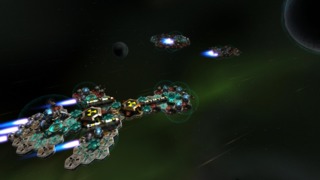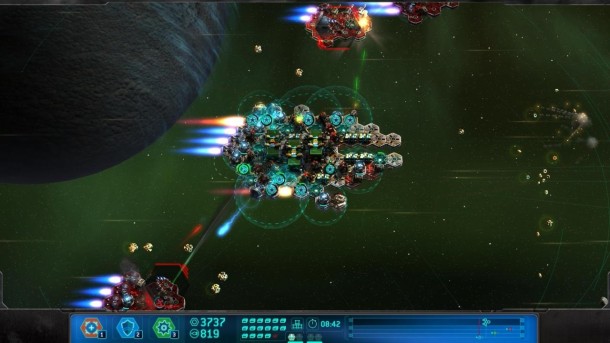Space Run Review
The conquest of space is still a romantic idea. We dream of the day when we can visit a theme park on the moon, or ride aboard a flying cruise ship as it sails the skies of a watery planet. In all likelihood, however, we will still be clocking away at 9-to-5 jobs trying to make an honest living in space, once we get there. In Space Run, you find yourself as a planetary delivery man, traveling the interstellar highway and delivering cargo. Taking cues from tower defense games, Space Run sets you against roving asteroids and troublesome space pirates while effortlessly blending challenging gameplay with infectious charm and a witty sense of humor.
The star of the game is Buck Mann, the manliest space man who ever manned space. Sporting a wry smile and a sarcastic attitude, Buck is an unabashed amalgam of every space-faring smuggler and bounty hunter, complete with the mandatory gambling debt. But despite the obvious cliches, Buck's presence during brief moments of exposition never overstays its welcome thanks to how well his personality stacks up against the charming yet equally stereotypical cast of supporting characters. Buck, along with his android partner, Adaam-12, sets out on shipping missions handed down by an eclectic group of employers. They range from a stone-tough businesswoman, to a shady mafioso looking to unload shady nuclear goods, to a rich playboy hoping to show some folks a good time, how else, but by strapping them to a ship that typically sails through asteroid belts and gunfire. The well-written script, fully voiced by an excellent cast, is generally funny, and the sharp sense of humor kept me smiling through every cutscene. The fantastic art direction coupled with nods to sci-fi influences ranging from Star Wars to Futurama is also a nice touch.
Your job as a space runner is to safely transport cargo from a starting location to a distant star port for delivery, a task easier said than done. At the onset of each mission, you place cargo modules of varying sizes on the hexagonal panels that make up your ship. The placement is tricky, because cargo can be as innocuous as some standard shipping crates, or as dangerous as temperamental nuclear armaments (that, yes, explode, causing some nasty damage) and alien crystals that drain power from surrounding panels. The necessary preparation is important because the last thing you want in the middle of an intense battle against swarming pirates is to be unable to place weapons due to de-energized panels or ones playing host to a pod of squealing tourists.

Getting your cargo safely to port takes speed and strategy. You view the field from an overhead angle that encompasses a large area of space around your ship. Radar warns you of incoming asteroids and enemy spacecraft, as well as their direct line of approach and chosen flight path. Also displayed is a countdown timer, which gives you precious few seconds to defend the ship by placing cannons, or shields if needed. Small asteroids and pirate drone ships are easily dispatched by a laser cannon or two, while larger craft may call for more powerful cannons or missile turrets. With a 360-degree field, enemies come at you from all angles, and as in most tower defense games, the difficulty ramps up as you progress.
Deciding when and where to place needed modules is mostly reactionary, because each fight forces you to rethink your strategy as you go along. There are moments when one ship you face is easily taken out with a barrage of missiles, but the next one is equipped with anti-missile defenses, rendering your tactics useless. Placed modules can be recycled and replaced in real time, and thinking quickly on your feet means the difference between creating safe passage for your cargo and watching it get burned to cinders.

You start out against small vessels that do little more than pester. But soon you find yourself plowing through asteroids large enough to tear your hull to shreds, because large pirate vessels strike from all sides using an assortment of powerful weaponry. The occasional boss fights against Space Run's pirate captains, who command enormous ships bristling with cannons, missiles, and shields, are harrowing, white-knuckled experiences from start to finish. Time is also a consideration, as you're always racing against the clock. To get to port faster, you must build engine thrusters, and the more you have, the quicker you reach your destination.

Reputation, displayed as stars, is earned at the end of each mission. How fast you get to port, as well as how much of your cargo is left intact, changes the number of stars gained as well as the size of your hard-won paycheck. You earn a currency called hexnuts by destroying enemies, asteroids, and the occasional neutral transport ship, and also reap hexnuts at the end of the level based on your performance. Hexnuts are exchanged in Space Run's in-game shop, where you can purchase offensive or defensive modules, or upgrade currently owned ones to be more powerful. The upgrading system is deep and varied, and the outcome of many battles changes drastically based solely on choosing the right upgrade or weapon related to the current mission at hand. Older levels can be replayed to earn a higher reputation and, in turn, more cash for upgrades. If you find yourself stuck on a mission, retreading a level or two can earn you the cash needed to even the odds.
Space Run shines from the depths of space, from the challenging gameplay to the deep strategy mechanics. I looked forward to every cutscene with glee, whether it featured Buck Mann talking terms with an employer, or had me trading fightin' words with pirates. There isn't much to gripe about, except that spoken words and the text in chat bubbles don't always match, and there is an occasional misspelled word, but that is just nitpicking. Overall, Space Run is an immensely enjoyable ride, starting with the initial docking bay, and lasting all the way to the final delivery.









